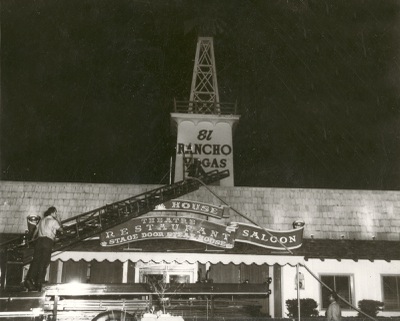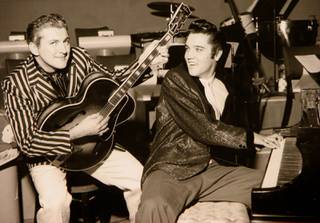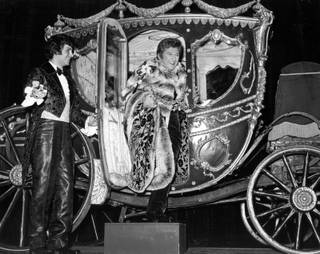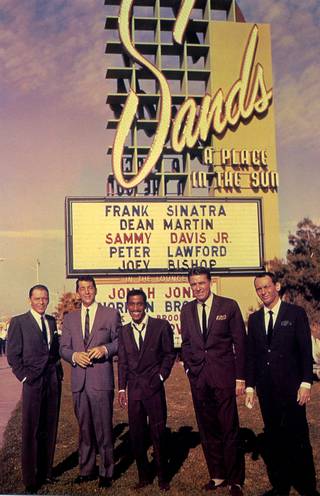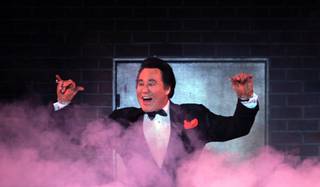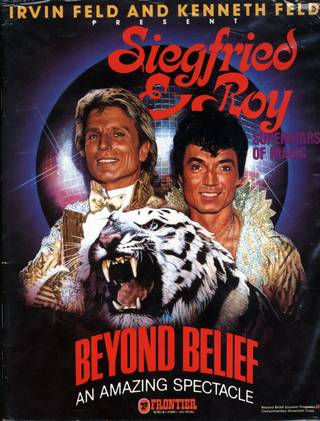Today’s visitors heading south on the Las Vegas Strip are splashed with glittering enticements that beckon them to see world-class performances and masterful sets, featuring A-list celebrities.
But go back six decades, sweep away the jumbo video boards and electric neon.
Before central air conditioning and eye-catching neon lights, the Las Vegas Strip entertainment scene started in the western-themed El Rancho Vegas, a motor lodge located on Highway 91.
When the El Rancho opened during World War II, it featured a gas station, $5-a-night rooms, a casino, and a swimming pool just 50 feet off the highway. California celebrities flocked to the desert oasis marked by a neon-lit windmill.
The resort, located just south of what is now Sahara Avenue on the west side of Las Vegas Boulevard, was the first hotel to use big names to attract crowds after it opened April 3, 1941.
The El Rancho’s earliest headliners included Sophie Tucker, Joe E. Lewis, Peggy Lee, Zero Mostel, Guy Lombardo, Milton Berle, Dean Martin, Eartha Kitt, Kay Starr, Sammy Davis, Jr., and the Ritz Brothers, among others.
However, the El Rancho sometimes had a poor track record for paying its stars. Entertainers including trumpeter Harry James, Betty Grable, Steve Lawrence and the Will Mastin Trio (with Sammy Davis, Jr.) threatened to sue the joint after it failed to compensate them.
But that risk did not keep the big stars away. Other 1950s notables that came to play Vegas, included the Marx Brothers, Judy Garland, Nat King Cole, Lena Horne and Abbott & Costello.
The El Rancho’s storied entertainment history came to an abrupt end at 4:30 a.m. on June 17, 1960, when a huge fire engulfed the resort.
Performers Pearl Bailey, Phil Ford and Mimi Hines were engulfed in black smoke as they returned to the hotel after doing news interviews. The smoke was so thick that it obscured almost everything, causing Bailey to accidentally back her car into a tree in her frantic efforts to escape.
Ford, who had been doing a comedy routine at the hotel with wife, Mimi, led the ladies coughing and dazed from the smoke and flames, to safety.
Grable felt a special loss after the El Rancho blaze. She had been starring at the hotel with a lavish revue and had lost more than $10,000 worth of costumes in the fire. She stood outside weeping openly, and watched as the flames leaped higher and higher, consuming the eye-catching windmill out front.
Comedian Red Skelton showed up and took numerous photographs of the blaze. People lined the streets, some bringing their children to view the early morning fire.
It took only an hour for the flames to destroy the resort. But by then, several other resorts had opened along the Strip, attracting even more top-flight entertainment talent.
Entertainment on the Rise
Las Vegas did not become an entertainment showcase overnight. In some places, that road was a long and tedious journey.
For instance, when Jimmy Durante opened the Flamingo on Dec. 26, 1946, the room was barely half filled. Durante played to fewer than 80 people, even though Billy Wilkerson’s dream of an American Morocco, funded by mobster and defacto owner Benjamin “Bugsy” Siegel, had prepared to fly in an audience. Siegel had leased three TWA Constellation planes to fly rich and famous guests from Los Angeles to Las Vegas.
However, unusual winter storms kept the planes grounded in California.
When Rose Marie came onstage the next night, the audience was even smaller, shrinking to 20. Durante said it was the smallest crowd he’d every seen, including his saloon days.
Part of the problem seemed to be that the Flamingo had only 90 rooms, a casino, a showroom and a coffee shop. Each of the hotel rooms existed in varying states of disrepair, furnishings ran $11,000 per room and each room had to have its own private sewer system, by Siegel’s orders.
Guests wishing to sleep had to return to the El Rancho or the Frontier where they paid $5 a night for a comfortable bed.
By New Year’s Eve, Lucille Ball and Desi Arnez, George Jessel and Leo Carillo – best known as Pancho, the Cisco Kid’s sidekick – were guests at the Flamingo.
But it wasn’t enough, by February Siegel closed the Flamingo for a month because it was doing such poor business.
It reopened on March 1, 1947 as the Fabulous Flamingo. The Andrews Sisters – Patty, LaVerne and Maxene – mingled with the guests along with Joan Crawford and the Ritz Brothers.
Once the Fabulous Flamingo and the El Rancho pioneered stars in Strip showrooms, Las Vegas began building its reputation as the "Entertainment Capitol of the World."
The Desert Inn opened April 24, 1950 with performers Edgar Bergen and his wooden dummy Charlie McCarthy, actress Vivian Blaine and the Donn Arden dancers played to a full house in the Painted Desert Showroom.
Not all the stars were onstage either. In the 1950s, the Desert Inn’s Wilbur Clark attracted the likes of president-elect John F. Kennedy and the Duke and Duchess of Windsor.
In 1952, Milton Prell opened the exotic Sahara across the street from the El Rancho. Guests could leave the folksy El Rancho for plush red and blue carpeting, flashing lights and cocktail waitresses in exotic, revealing costumes at the Arabian-themed resort.
John Wayne, Fred MacMurray and Elvis Presley (who never headlined at the Congo Room) often played the Sahara’s slots late into the night. In the 1960s, the Beatles stayed at the Sahara when they played to frenzied teenage fans at the Las Vegas Convention Center.
The Sands opened on Dec. 15, 1952, with comedian Danny Thomas starring in the Copa Room. Frank Sinatra, having arrived a year earlier, signaled a new glamorous and edgy excitement for Vegas showrooms. However, it would be seven more years before “The Rat Pack” emerged on the Las Vegas Strip.
Sammy Davis, Jr., who would join Sinatra, lived and performed in the wee hours off-Strip at the Moulin Rouge with the likes of Nat King Cole and Count Basie. The Moulin Rouge was the only hotel in Las Vegas at the time which was integrated.
In 1954, actor and future U.S. President Ronald Reagan made his only appearance on a Las Vegas stage as a song and dance man at the Last Frontier.
Elvis and Liberace
At 21, Elvis Presley played Las Vegas for the first time, making an appearance at the New Frontier on April 23, 1956. Presley was billed as “The Atomic Powered Singer” as nuclear weapons exploded in the predawn darkness at the Nevada Test Site, 65 miles northwest of Las Vegas.
The nickname referred to Presley’s dynamic, gyrating style as well as the above-ground nuclear blasts exploding in the desert air.
Given that theme, Presley appropriately bombed.
That, however, did not sour Presley on Vegas.
In fact, the city became the movie set for Elvis in “Viva Las Vegas,” which co-starred Ann-Margret. Elvis spent several weeks on location.
On May 1, 1967 Elvis married Priscilla Ann Beaulieu in a small private ceremony at the Aladdin (now Planet Hollywood). He was 32, she was 21.
Elvis finally captivated Las Vegas audiences, breaking attendance records during a four-week, 57-show run in July and August 1969 at the new, 1,500-room International Hotel, now known as the Las Vegas Hilton.
The day after Elvis opened, the resort’s president, Alex Shoofey, sat in the showroom sipping coffee with Presley’s manager, Col. Tom Parker.
Despite the successful opening night, Shoofey was unhappy because the “King of Rock ‘n’ Roll” had been contracted for only two weeks a year.
“Listen,” Shoofey recalled telling Parker in his 2003 UNLV oral history interview, “I’d like to extend your contract.”
Parker balked: “Alex, it’s too early. Let’s find out whether he (Presley) can make it or not.”
“I’ll take that chance right now,” Shoofey said. He then scribbled a new pact on the tablecloth. It resulted in more than 700 sell-out performances from 1969 to 1976, resurrecting Presley’s career and making him the Las Vegas icon, imitated to this day by Flying Elvi and other costumed wonders.
Elvis returned to the International Aug. 9, 1971 and signed a five-year contract to perform twice a year. But on Aug. 16, 1977, Elvis died at Graceland.
Not to be outdone in the 50s, Nevada’s first high-rise hotel, the 11-story Riviera, opened its doors April 20, 1955 with Liberace as the opening night star. Liberace would become a glittering icon of Las Vegas. At best a competent pianist, Liberace perhaps reached his zenith in Las Vegas in the 1970s through the early 80s.
Nicknamed “Mr. Showmanship” for his glitzy, flamboyant sequined outfits, Liberace drew loyal audiences with his big smile and enthusiasm while tickling the ivories.
In 1971, he wore patriotic red, white and blue hot pants on stage during a performance at Caesars Palace. The $4,000 outfit – somewhat cheap by Liberace’s extravagant standards – included red, white and blue jeweled socks and shoes and a matching handbag.
In 1974, Liberace signed a $2.5 million contract for a 25-week Las Vegas engagement.
A year later, it was announced that he was both Las Vegas’ and Lake Tahoe’s top drawing performer, earning $125,000 a week. That amount blossomed to nearly $300,000 a week by the end of his career.
On April 15, 1979, Liberace opened the Liberace Museum in Las Vegas. The museum — which houses his collection of rare and antique pianos, classic cars, his sequined and bejeweled stage costumes and jewelry, and other memorabilia — serves as the key funding arm for his non-profit Liberace Foundation for the Performing and Creative Arts. The foundation funds scholarships for schools and colleges across the nation.
Liberace continued to flaunt feathers and fur onstage and off until his death from AIDS in February 1987.
The Rat Pack
Sinatra and his pals belonged to a Hollywood drinking group including Humphrey Bogart and Lauren Bacall. After Bogart died Jan. 14, 1957, Sinatra formed his own group with the likes of Davis, Dean Martin, Joey Bishop, Peter Lawford and Shirley MacLaine.
Davis headlined at the Frontier before joining Sinatra and the rest of the Rat Pack as part of “the clan,” a name both Davis and Sinatra grew to dislike. Davis didn’t take to the name, saying it invoked the Ku Klux Klan. Sinatra then renamed the group “the Summit,” but the Rat Pack caught on and held the media’s attention.
Davis suffered a setback Nov. 19, 1954 when he almost died in an automobile accident in Victorville, Calif., on a return trip from Las Vegas to Los Angeles. Davis lost his left eye as a result. After the Rat Pack broke up, Davis continued to draw huge Las Vegas audiences.
The Rat Pack’s claim to fame came in January 1959 when Sinatra conducted the orchestra on Martin’s album, “Some Came Running.” Then on Jan. 20, 1960, Sinatra joined Martin onstage at the Sands to sing “Sleep Warm.” The Rat Pack became a Strip routine and then turned into Las Vegas legends.
Sinatra starred as Danny Ocean in the 1960s film “Ocean’s Eleven,” the black and white film legacy that was shot in Las Vegas and included every member of the Rat Pack.
The Rat Pack stayed together until the end of the 1960s.
Not long after billionaire Howard Hughes bought the Sands in 1967, Sinatra had a falling out with hotel management over his credit in the casino. After pitching some furniture at Sands casino boss Carl Cohen, who threw a punch that knocked Frankie’s front teeth out, Sinatra signed a contract with Caesars Palace.
While some thought the Rat Pack would stay together after Sinatra left the Sands, Martin played the Copa Room by himself for another year. Martin had first performed in Las Vegas in 1949 at the Flamingo with Jerry Lewis. Back then, Martin and Lewis together earned $15,000 weekly.
In the 1960s, the Rat Pack and Elvis Presley, after initial indifference from Strip audiences, ruled the Las Vegas entertainment scene’s roost.
Wayne Newton: “Mr. Las Vegas”
As the Rat Pack era and the Elvis phenomenon faded, a new wonder appeared on the Las Vegas Strip: Wayne Newton.
According to the late Las Vegas Sun entertainment columnist Joe Delaney, Newton holds all of Las Vegas’ records for number of weeks played, number of hours onstage (five or more hours per night total, seven nights a week) and total crowd counts during his peak period. In the 70s, he divided his time between Howard Hughes’s Desert Inn, Frontier and Sands.
Following the death of Walter Kane, Hughes’s entertainment director, Newton headlined at Bally’s, Caesars Palace and the Las Vegas Hilton. He branched out to the MGM Grand, Branson, Mo., and the Stardust in the 1990s and beyond.
Newton began his Las Vegas career after having his own radio show at age six in Norfolk, Va. Born Carson Wayne Newton on April 3, 1942, “Mr. Las Vegas” moved with his family to Phoenix for better climate conditions where Newton and his brother, Jerry, worked radio and television as the Newton Brothers.
The next stop for the Newton Brothers was the Fremont Hotel in downtown Las Vegas. Hotelier Ed Torres was their first Vegas mentor, having them work the Fremont lounge six nights a week, six shows a night, 45 minutes on, 15 minutes off, Delaney said.
“Torres was to Wayne Newton what the late band leader, Tommy Dorsey, was to Frank Sinatra: a primary learning experience,” Delaney said. However, Jerry was not destined for Las Vegas stardom and he faded from the spotlight.
Comedian Jackie Gleson and singer Bobby Darin both recognized the Newton talent. Darin suggested the name change to Wayne Newton and a star was born.
Magic Moves Center Stage
As the headliners faded from Strip showrooms, big production shows such as Siegfried & Roy, Cirque de Soleil and others moved center stage in the 1990s and attracted a wider market, according to late UNLV historian Hal Rothman.
Siegfried Fischbacher and Roy Horn were German-American entertainers whose meteoric careers played out primarily on the Las Vegas stage at resorts including the old MGM Grand (now Bally’s), the Stardust, the Frontier and finally the Mirage.
Their show featured amazing illusions and wild animals, particularly white tigers and white lions.
Siegfried was the magician in the act while Roy was the animal expert, having grown up working with exotic beasts.
They met in 1959 while working on a German ocean liner – Siegfried as a cabin steward and Roy as a waiter. The duo soon were performing magic tricks for passengers and got their own show aboard the vessel.
They first appeared in Las Vegas in 1972. At the time, many hotel executives scoffed at magic in Vegas showrooms. Not only did Siegfried & Roy prove them wrong, they ushered in an era of family-friendly entertainment in Las Vegas.
In 1990 Steve Wynn gave the seasoned pair a $57.5 million a year contract to – as their slogan said – “disappear nightly” at his new hotel, the Mirage, the Strip’s first mega-resort.
In 2000, Siegfried & Roy, then reported to be one of the 10 highest paid celebrity acts in the United States, signed a lifetime contract with the hotel. Unfortunately for the act and the hotel, that lifetime lease lasted only three more years.
The act retired after Roy suffered near fatal injuries when one of the tigers attacked him during a performance Oct. 3, 2003.
The duo had performed more than 5,700 times in Las Vegas before the attack.
A Club at Every Resort
Hip clubs on the Strip came seemingly out of nowhere. In 1995, a few small clubs began to alter the scene. Places such as the Metz Club, the Beach and Drink and Eat Too attempted to draw a crowd of younger conventioneers and tourists as well as locals.
When the Hard Rock Hotel opened in March 1995, a new Las Vegas appeared, aimed at the young and the hip. A shrine for the rock ‘n’ roll generation, the Hard Rock attempts to reach the hip Baby Boomers – and their families. With Stevie Ray Vaughn guitars on display and Sheryl Crow clothing exhibited, the Hard Rock blazed a trail to a different audience.
The smaller clubs had the market to themselves for a brief moment. Then, the big hotels got wise to the fact that their patrons were running to other places because the entertainment on the premises was not quite to their liking, Rothman said in a column that appeared in the Las Vegas Sun Oct. 15, 2006.
Then, in 1995, Club Rio opened atop the Rio, the first hip nightclub inside a hotel. Other hotels looked at that niche, realizing they had missed a significant opportunity,.
The year 1997 was the turning point. Two of the largest properties figured out an answer to the question of the 21-34-year-old demographic. Upscale nightclubs such as Ra at the Luxor and Studio 54 at the MGM Grand were announced. Ra opened New Year’s Eve 1997.
Corporate managers at the MGM Grand and the Luxor used their resources to extract ideas from smaller entrepreneurs and succeeded beyond their biggest dreams, so completely that they changed the market, Rothman said.
From there, every major hotel soon had a hip nightclub and each was full of gyrating patrons. With the 2001 opening of the off-Strip Palms, the city had a property devoted to the chic — where celebrities became visual attractions and cool currency. The ante continues to climb as more and more clubs open.
Once again, Las Vegas has done what the city does best: It anticipates desire where competitors only reflect it, Rothman wrote.
Sources: Steve Fischer’s “When the Mob Ran Vegas;” Las Vegas Sun articles by George Stamos; Sun columns by the late UNLV historian Hal Rothman; Sun stories by Jerry Fink; Sun stories by Joe Delaney and UNLV historian Eugene P. Moehring’s “Resort City in the Sunbelt Las Vegas, 1930-1970.”

